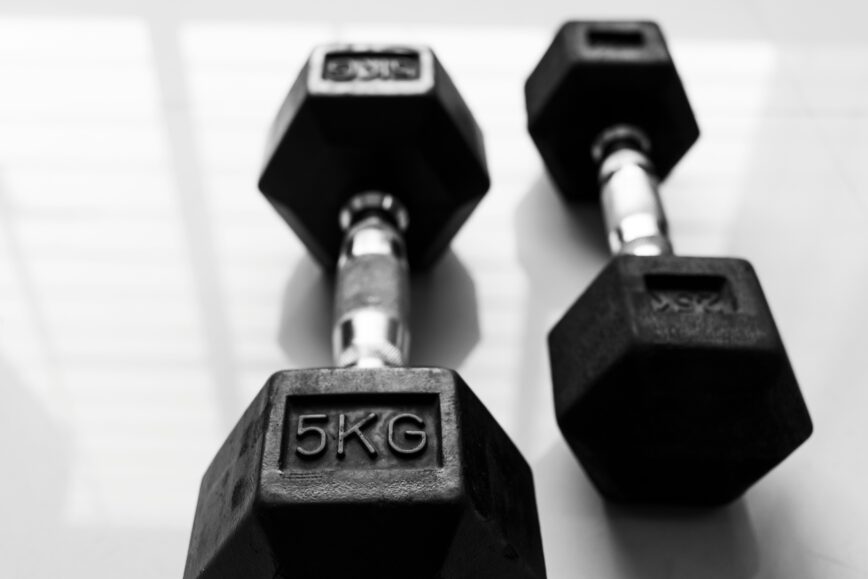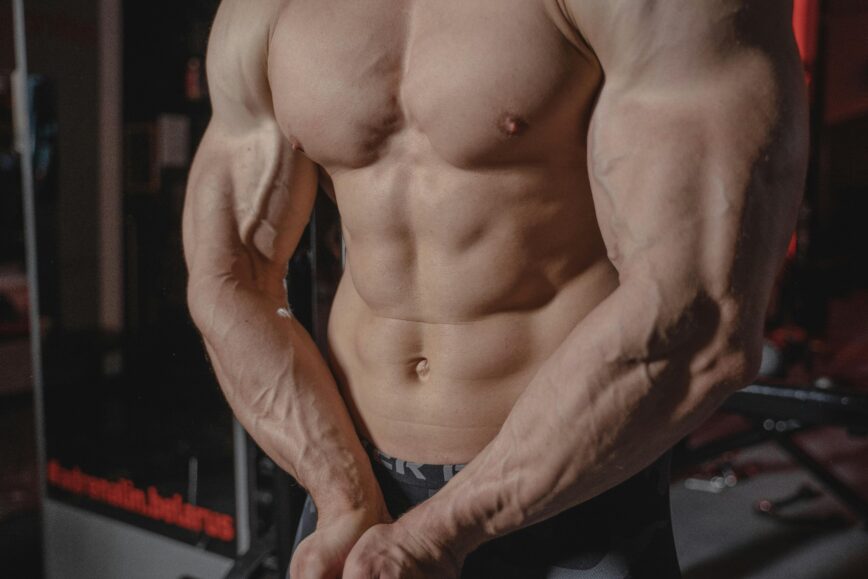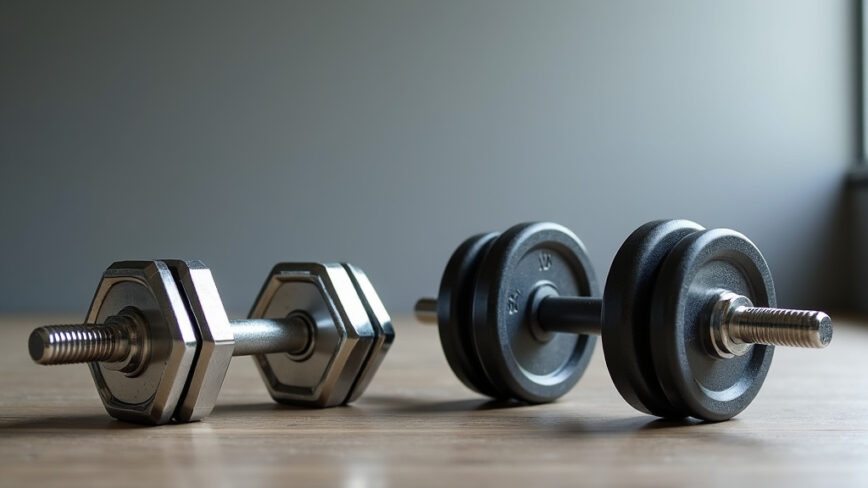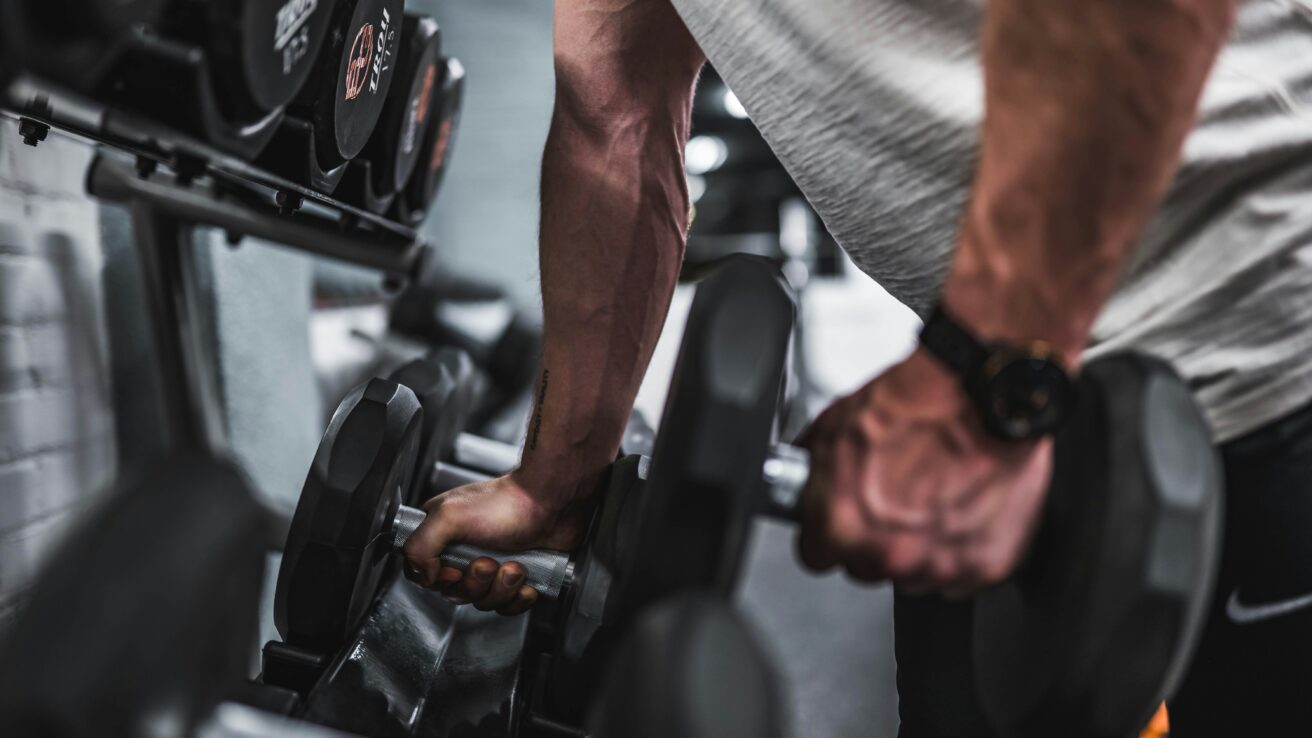Tired of complex gym equipment and crowded weight rooms? Let me share what transformed my fitness journey – a simple pair of dumbbells. You can build serious upper body strength and muscle with these versatile tools, whether you’re working out in your living room or at the gym.
As a strength coach, I’ve seen remarkable transformations using just dumbbells to target every major muscle group in the chest, back, shoulders, and arms. According to research from the Journal of Strength and Conditioning Research, training with free weights like dumbbells can increase testosterone levels and muscle growth more effectively than machines.
I love how dumbbells force you to engage stabilizer muscles and work through natural movement patterns. They’re perfect whether you’re just starting your fitness journey or looking to break through a plateau. And with studies showing that dumbbells are as effective as barbells for building strength and size, you can achieve an impressive upper body transformation with minimal equipment.
Benefits of Dumbbell Training for Upper Body
Unlike machines or barbells, dumbbells create an unstable training environment that forces your muscles to work harder during each repetition. Research demonstrates that dumbbell exercises increase muscle fiber recruitment by up to 50% compared to fixed-path movements.
A primary advantage is improved muscle stabilization. When performing overhead presses or chest presses with dumbbells, your shoulders and core must engage fully to control the weights. This enhanced stabilization leads to better overall strength and reduced injury risk.
Dumbbells also allow for a greater range of motion compared to barbells or machines. For example, during a dumbbell bench press, you can lower the weights further and bring them closer together at the top, leading to better chest activation and muscle growth.
Perhaps most importantly, dumbbell training excels at identifying and correcting muscle imbalances. Since each arm works independently, your stronger side cannot compensate for the weaker one as it might with a barbell. This promotes balanced, symmetrical development over time.
The freedom of movement that dumbbells provide also reduces joint strain compared to fixed-path machines. You can adjust the angle and path of each exercise to accommodate mobility limitations while maintaining workout effectiveness.
Core engagement is another significant benefit, as your midsection must work continuously to stabilize your body during standing presses, rows, and other movements. This transforms basic upper body exercises into total-body strengtheners.
Additionally, dumbbells offer exceptional versatility, enabling unilateral (single-arm) exercises that improve coordination and add variety to your training. This helps prevent plateaus while building functional strength.
The ability to quickly modify exercises by changing grip position, angle, or switching between bilateral and unilateral movements makes dumbbells ideal for progressive overload – the fundamental driver of muscle growth and strength gains.
| Equipment | Stabilization Requirement | Muscle Activation | Range of Motion |
|---|---|---|---|
| Dumbbells | High | Stabilizer and primary muscles | Greater |
| Barbells | Moderate | Primary muscles | Limited |
| Machines | Low | Primary muscles | Fixed |
Essential Upper Body Dumbbell Exercises

Mastering fundamental dumbbell exercises is key to building upper body strength and muscle. These three essential movements will help you develop a stronger, more defined upper body.
Dumbbell Chest Press: Building a Powerful Chest
The dumbbell chest press is an essential exercise for developing chest strength and muscle definition. Unlike the barbell variation, dumbbells allow for a greater range of motion and help address muscle imbalances between sides.
Begin by lying on a flat bench with your feet planted firmly on the ground. Hold a dumbbell in each hand at chest level, palms facing forward, with your elbows bent at approximately 90 degrees.
Press the dumbbells upward until your arms are extended, but avoid locking your elbows to maintain tension on the chest muscles. Lower the weights slowly, taking 2-3 seconds on the descent for maximum muscle engagement.
Dumbbell Rows: Sculpting a Strong Back
Dumbbell rows effectively target your back muscles while improving posture and overall upper body strength. This exercise engages your latissimus dorsi and trapezius muscles.
Position yourself with one knee and hand on a bench, keeping your back straight and parallel to the ground. Hold the dumbbell with your free hand, allowing it to hang straight down.
Pull the dumbbell straight up toward your hip, keeping your elbow close to your body. Focus on squeezing your back muscles at the top of the movement for maximum activation.
Shoulder Press: Developing Powerful Deltoids
The shoulder press is a fundamental movement for building shoulder strength and stability. This exercise targets all three heads of the deltoid muscle for comprehensive shoulder development.
Start by sitting or standing with a dumbbell in each hand at shoulder level. Your palms should face forward, and your core should remain engaged throughout the movement.
Press the weights overhead until your arms are fully extended, while maintaining a slight bend in your elbows at the top. Lower the dumbbells back to shoulder level in a controlled manner.
Remember, proper form always trumps heavy weight. Start with a weight that allows you to perform 8-12 controlled repetitions while maintaining perfect technique.
| Exercise | Targeted Muscles | Benefits |
|---|---|---|
| Dumbbell Chest Press | Chest (Pectorals) | Improves muscle imbalances, allows greater range of motion |
| Dumbbell Rows | Back (Latissimus Dorsi, Trapezius) | Improves posture, enhances upper body strength |
| Shoulder Press | Shoulders (Deltoids) | Enhances shoulder strength and stability |
| Mountain Climbers | Abdominals | Increases core strength and endurance |
| Weighted Dips | Chest | Builds chest strength and muscle definition |
| Barbell Full Squats | Quadriceps | Enhances leg strength and muscle mass |
Building Your Upper Body Dumbbell Workout Routine

Creating an effective dumbbell workout routine requires careful attention to sets, reps, and rest periods to maximize your gains. As someone who’s designed hundreds of training programs, I’ve found that success depends on progressive overload and proper workout structure.
A well-designed upper body routine typically includes 3-4 sets per exercise with 8-12 reps for muscle building, or 4-6 reps for strength gains. Your muscles require both adequate stimulus and sufficient recovery time between sets.
Structuring Your Sets and Rest Periods
For beginners, I recommend starting with 2-3 sets per exercise with longer rest periods of 90-120 seconds between sets. This approach ensures proper form development and reduces the risk of early fatigue.
Intermediate lifters can progress to 3-4 sets with 60-90 seconds rest, while advanced trainers might perform 4-5 sets with 45-60 seconds rest for increased intensity. Remember, shorter rest periods increase metabolic stress but may reduce the weight you can handle.
When training for strength, studies show that longer rest periods of 2-3 minutes between sets enable better performance and maximum force production.
Progressive Overload Strategies
The key to continuous improvement lies in progressive overload – gradually increasing the demands on your muscles. Here are proven methods to implement this principle:
- Increase weight by 5-10% when you can complete all sets with good form
- Add 1-2 reps per set before increasing weight
- Increase sets from 3 to 4 before adding weight
- Decrease rest periods by 15 seconds while maintaining weight
Sample Upper Body Workout Structure
For optimal results, organize exercises from largest to smallest muscle groups. Here’s an effective sequence based on research-backed principles:
Start with compound exercises targeting chest and back, using 3-4 sets of 6-10 reps with 90 seconds rest. Move to shoulder exercises with 3 sets of 8-12 reps and 60 seconds rest, finishing with arm exercises using 2-3 sets of 12-15 reps.
Monitor your progress and adjust variables like weight, sets, and rest periods systematically. This structured approach ensures consistent progress while minimizing plateau risks.
| Experience Level | Sets | Reps | Rest Period |
|---|---|---|---|
| Beginner | 2-3 | 12-15 | 90-120 seconds |
| Intermediate | 3-4 | 8-12 | 60-90 seconds |
| Advanced | 4-5 | 6-10 | 45-60 seconds |
Advanced Dumbbell Techniques for Upper Body

Ready to enhance your upper body workouts? Advanced dumbbell techniques can help you overcome plateaus and stimulate new muscle growth. Here are proven methods that professional trainers use to elevate dumbbell training effectiveness.
Drop Sets: The Art of Progressive Fatigue
Drop sets involve performing an exercise to failure, then immediately reducing the weight and continuing with more reps. This technique pushes your muscles beyond their usual limits, creating optimal conditions for enhanced growth.
For an effective dumbbell drop set, start with a weight you can lift for 8-10 reps. Upon reaching failure, quickly switch to dumbbells 5-10 pounds lighter and continue until you cannot perform another quality rep.
Consider this example for dumbbell shoulder presses: Begin with 30-pound dumbbells for 8 reps, drop to 25 pounds for 6-8 more reps, then finish with 20 pounds until failure. Maintain proper form throughout the sequence.
Supersets: Maximizing Workout Efficiency
Supersets pair two exercises performed back-to-back with minimal rest. This technique increases workout intensity and metabolic stress while saving time – both crucial factors for muscle growth.
Create effective supersets by pairing opposing muscle groups, like chest and back. For example, perform dumbbell bench presses immediately followed by bent-over rows, resting only after completing both exercises.
Another effective approach is combining exercises for the same muscle group, such as dumbbell lateral raises followed immediately by shoulder presses. This pre-exhaustion technique thoroughly fatigues the target muscles.
Tempo Training: Quality Over Speed
Tempo training involves controlling the speed of each repetition to increase time under tension. This technique enhances muscle fiber recruitment and stimulates growth through increased mechanical stress.
A classic tempo prescription follows a 4-1-2-0 pattern: lower the weight for 4 seconds, pause for 1 second at the bottom, lift for 2 seconds, with no pause at the top. This approach works particularly well with dumbbell movements like bicep curls or chest flyes.
For optimal results, use lighter weights than normal when implementing tempo training. Focus on maintaining precise control throughout each rep rather than moving heavy weights quickly.
Nutrition and Recovery for Optimal Results
Proper nutrition and recovery strategies are essential for maximizing gains from your upper body dumbbell workouts. Experience has shown that even the most intense training sessions require the right nutritional foundation for optimal results.
Your total daily protein intake serves as the cornerstone for muscle growth and recovery. Research shows that consuming 1.6-2.0 grams of protein per kilogram of body weight daily supports optimal muscle development and repair.
Strategic Meal Timing for Performance
Spreading your protein intake across 4-5 meals helps maintain a steady supply of amino acids for muscle repair throughout the day. I recommend aiming for 20-30 grams of protein at each meal, with slightly higher amounts for older adults.
Pre-workout nutrition deserves special attention. About 2-3 hours before training, consume a balanced meal containing complex carbohydrates and lean protein to fuel your session. Think oatmeal with protein powder or brown rice with chicken breast.
Your post-workout window presents a crucial opportunity. Within 30-45 minutes after training, provide your muscles with both protein and carbohydrates to jump-start recovery. A protein shake with banana or a turkey sandwich works great here.
Rest and Recovery Essentials
Quality sleep plays an indispensable role in muscle growth and recovery. During deep sleep stages, your body releases significant amounts of growth hormone essential for tissue repair and muscle development.
Strategic rest days between upper body sessions allow for proper recovery. I typically recommend 48-72 hours between targeting the same muscle groups to prevent overtraining and optimize results.
Hydration is crucial in your recovery protocol. Even mild dehydration can reduce strength and performance by up to 10%. Aim for 3 liters of water daily, increasing intake around workouts.
Remember that muscle growth occurs during rest periods, not during workouts themselves. Without sufficient recovery time and proper nutrition, you risk fatigue, decreased performance, and plateaus in your progress.
| Activity Level | Protein Intake (g/kg BW/day) |
|---|---|
| Sedentary | 0.8 |
| Minimal Physical Activity | 0.8 |
| Moderate Physical Activity | 1.0 |
| Intense Physical Activity | 1.3 – 1.7 |
| Older Adults | 1.0 |
| Weightlifters/Training for Events | 1.2 – 1.7 |
| Safe Upper Limit | 2.0 |
| Chronic High Intake | 3.5 (Tolerable Upper Limit) |
Common Mistakes to Avoid in Upper Body Dumbbell Training

When embarking on an upper body dumbbell training journey, proper form and technique are crucial for both safety and results. I’ve seen countless fitness enthusiasts make preventable mistakes that limit their progress and risk injury.
One of the most fundamental errors I observe is improper wrist positioning during exercises. Your wrists should remain straight and rigid throughout each movement, with the weights stacked directly over your wrists. This alignment engages your forearm muscles properly and helps maintain control of the weights.
Another critical mistake is relying too heavily on momentum rather than muscle engagement. As a trainer, I often see people swinging their arms and using their back to lift weights that are too heavy for proper form.
Form and Technique Errors
The most common technique mistake is failing to maintain proper posture during exercises. Your core should stay engaged throughout each movement to protect your spine and ensure proper muscle activation.
Many beginners make the error of not completing full ranges of motion in their exercises. For example, during bicep curls, you should fully extend your arms at the bottom of the movement and fully contract at the top to maximize muscle engagement and results.
Bent wrists during pressing movements put enormous strain on your joints and can lead to serious injury. Always focus on keeping your hands, wrists, and forearms aligned in a straight line during every exercise.
Weight Selection Mistakes
Choosing weights that are too heavy is a recipe for disaster. I’ve learned through experience that using proper form with lighter weights is far more effective than struggling with heavy weights using poor technique.
Many people underestimate the importance of gradual progression. The Mayo Clinic recommends increasing your exercise intensity by just 10 percent each week for optimal results without risking injury or burnout.
Another common mistake is using the same weight for all exercises. Your lower body is typically much stronger than your upper body, so you’ll need to adjust your dumbbell weights accordingly for different movement patterns.
Recovery and Training Volume Issues
Overtraining is a serious concern that can lead to decreased performance and increased injury risk. According to exercise experts, your body needs adequate rest between workouts to repair and rebuild muscle tissue.
A critical error many make is not implementing proper warm-up routines. Research shows that performing at least five to ten minutes of cardio before starting your dumbbell workout helps prepare your muscles and significantly reduces injury risk.
Final Words
Building upper body strength with dumbbells isn’t just effective—it’s one of the most versatile and accessible ways to train. Whether you’re lifting at home or in the gym, mastering these movements can lead to serious muscle growth, improved stability, and enhanced overall fitness.
By focusing on proper form, progressive overload, and strategic recovery, you’ll maximize your results while reducing the risk of injury. And remember, consistency is key—stick to a structured routine, challenge yourself, and watch your strength and physique transform.
So, grab those dumbbells and get started. Your strongest upper body is just a few reps away!







